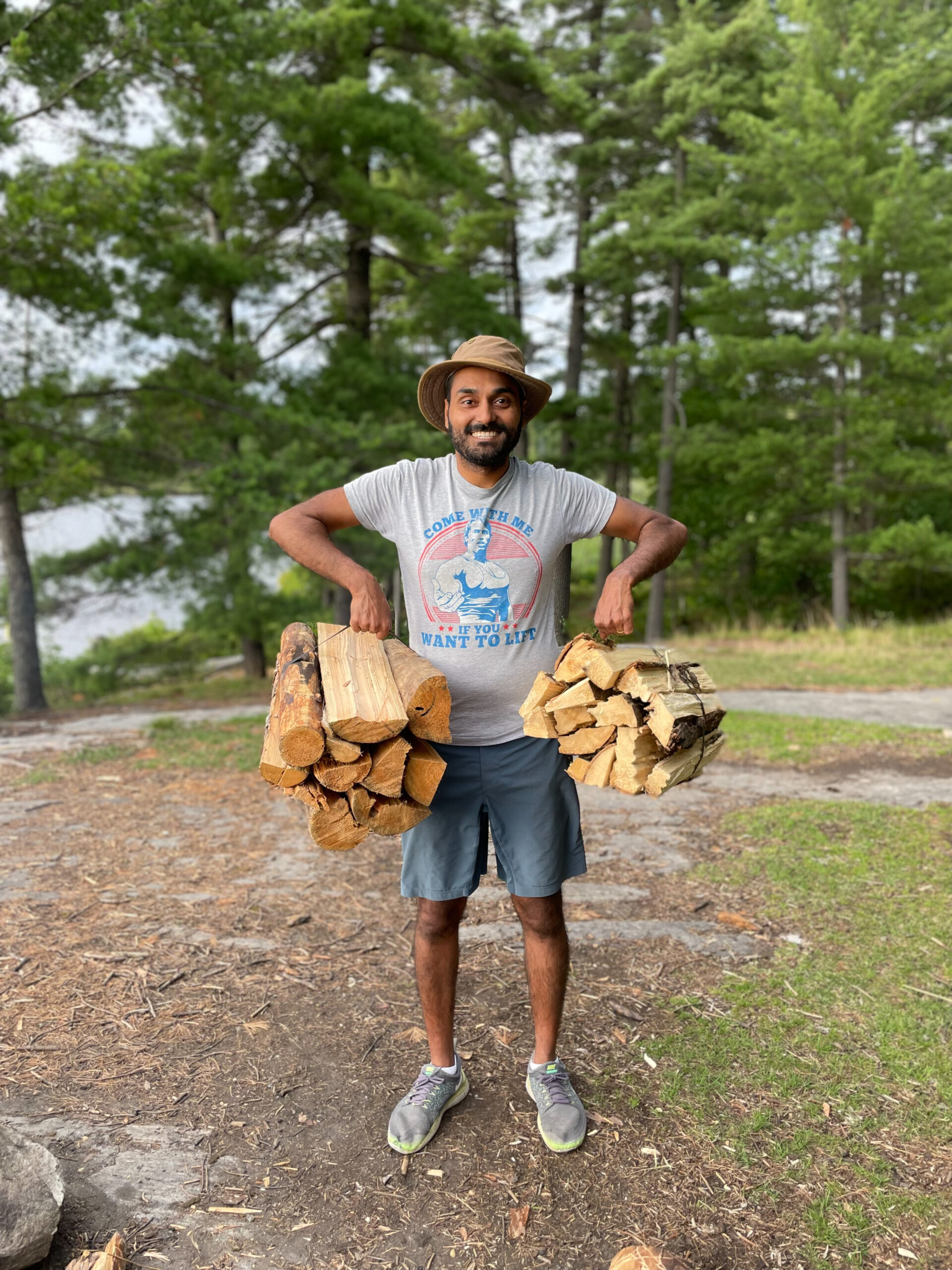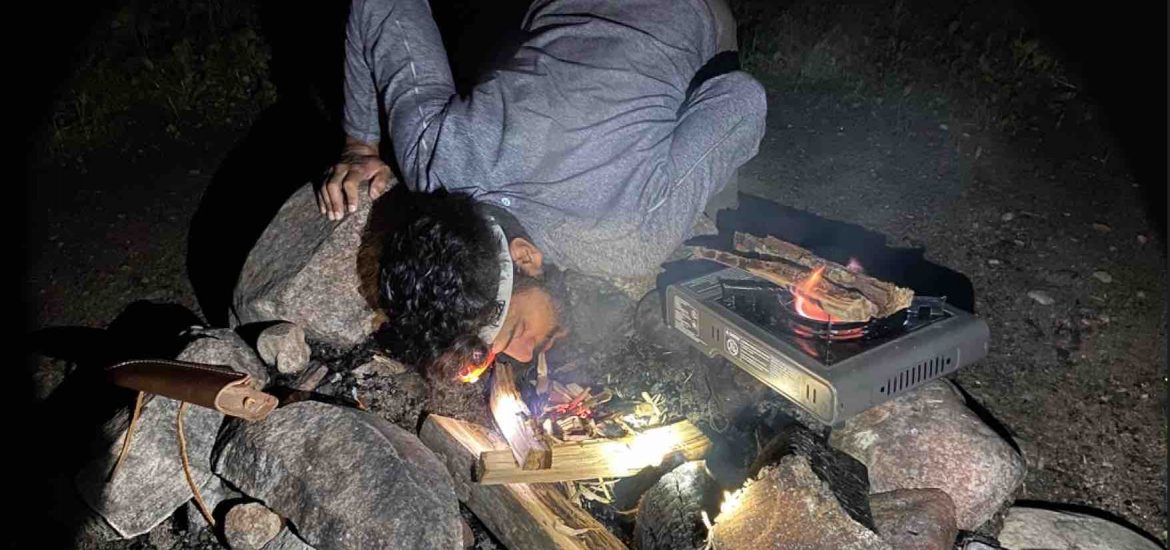When I think of camping, I think of cooking hotdogs and roasting marshmallows around a crackling campfire. For me, and many others, a campfire is a quintessential part of the camping experience.
And, to fuel your campfire, you might choose to purchase firewood to fuel your campfire at a campground, or pick it up beforehand. However, how much firewood do you actually need for your camping trip?
Well, there are a few factors that influence how much firewood you’re going to need which include:
- Will you be cooking on the fire?
- Will it be windy, raining, or cold?
- How dry is the wood?
- Are you using hardwood or softwood?
A general rule of thumb is that 1 bundle of firewood will last 2 hours for a moderately intense campfire. However, firewood type, size and weather conditions can dramatically change the amount of firewood needed.
So, let’s explore all the factors and determine how much firewood you’ll be needing for your next camping trip!

How Much Firewood is in a Bundle?
To start off, you first need to know how firewood is packaged for pick-up.
Typically, firewood is sold per bundle in mesh plastic bags. A standard bundle of firewood contains between 8 to 12 pieces of wood. Each piece of wood is 3 to 4 inches in diameter.
In some cases, firewood bundles contain kindling (thinner pieces of wood) to help campers start a fire. Kindling pieces are between 1 to 2 inches in diameter.
Depending on the type wood and level of dryness, each bundle can weigh between 20 to 30 pounds. And, each bundle of firewood is roughly the same size as a 50-pound bag of potatoes.
So, if you’re worried about space and weight, keep these dimensions and numbers in mind!
What Affects Firewood Burn Rate?
There are 3 factors that affect how fast firewood burns – wood size, wood type, wood dryness, and weather conditions.
Wood Size
Size has a dramatic affect on how fast wood burns, specifically the volume to surface area ratio.
Once a fire is established, adding very thin pieces of wood, results in a far more intense but short-lived fire compared to adding large logs.
This is because more surface area of wood is exposed to the flames and oxygen and is allowed to burn on a thinner pieces of wood.
When starting a fire, large logs are usually split into smaller sticks with an axe and shaved with a knife to create feather sticks. These smaller pieces and wood shavings are able to ignite much quicker and burn hotter because they allow more oxygen to flow to the surface.
So, if you’re planning on making your fire last longer, but want to use less wood, only add larger pieces of wood to keep the fire from becoming too intense.
Pro-tip: If you need the perfect knife or hatchet to build a campfire quickly and easily, check out my article on how to pick the best equipment for camping!
Softwood vs. Hardwood vs. Greenwood Explained
The density or hardness of firewood greatly influences how fast it burns. Generally, firewood is classified into two types: softwood and hardwood.
Geography, specifically latitude and altitude, dictates which type of trees can be harvested for firewood. Check out the image below for the range of different types of hardwood and softwood trees [Reference].
Softwood
Cedar, fir, pine, and poplar are examples of softwood trees. They are less dense than hardwood trees because they tend to grow faster. Softwood trees do not flower or produce leaves. Instead, they produce needles or scale-like leaves [Reference].
Because softwoods are less dense they tend to ignite faster making it easier to start a fire.
However, softwood crackle and pop, create a lot of smoke, and produce little sparks that can damage tents and tarps.
For light campfires in the summer, go for softwood.
Hardwood
Oak, birch, cherry, hickory, and maple are examples of hardwood trees. Hardwood trees grow slowly, produce flowers, fruits, and broad leaves.
Hardwoods are dense so they tend to last a lot longer in a fire and burn slower.
This is great if you want a fire to last all night long or want steady heat from the cold. The coals produced in a hardwood fire are much better for cooking, and create an even and long lasting heat source.
For cool or cold weather camping, hardwood is your best bet.
Greenwood
Normally, firewood is cut and allowed to dry for a year or so, creating “seasoned” firewood. This drying or seasoning process reduces the moisture content and makes the wood a lot lighter and MUCH easier to burn.
Greenwood, on the other hand, is a term used for freshly cut firewood that is heavier and high in moisture content.
Starting a fire with greenwood can be extremely difficult. Personally, I’ve had to artificially dry logs over a butane stove to get them to burn in a fire (pictured below).
Even creating thin shavings and igniting them didn’t produce a fire easily. I can usually get a fire going in under 5 minutes, but that time it took over 45 minutes…
So, make sure the firewood you pick up is seasoned for an overall better campfire experience!
Weather Influence on Campfires
Both rain and wind dramatically reduce the longevity of your firewood stockpile. A continuous deluge of rain douses a campfires heat. Therefore, in wet weather, a larger fire is often required to keep the coals from cooling off or rain water from extinguishing the fire.
Likewise, excessive winds can literally “blow” through your firewood rather quickly. That’s because air is one of the three major ingredients for a fire, the other two being fuel (wood) and an ignition source (flame). More wind means more airflow, more airflow means more oxygen delivered to the fire, and more oxygen leads to a more intense fire. A more intense fire burns hotter and quicker.
So, if you expect rain or high winds throughout your camping trip, expect to use more firewood.
Recommended Amount of Firewood for Car Camping
Car camping is great because your vehicle does all the heavy lifting, especially when it comes to carrying and transporting firewood.
However, if you’re campsite is located far from a source of firewood or you want to limit the amount of trips you need to make to pick up wood, it’s best to know how much firewood you’ll be needing for your stay.
Warm Weather Camping
For warm weather camping trips and moderately intense campfires, 1 bundle of firewood usually lasts about 2 hours. These campfires are perfect for roasting hotdogs, toasting marshmallows, sharing ghost stories much like “Are You Afraid of the Dark?”.
Cold Weather Camping
For cold and wet weather or excessively windy camping trips, where a campfire is primarily used for keeping warm, 1 bundle of firewood per hour is a good amount to bring.
For more intense, raging campfires, just double the amount of firewood and you should be good to go – it’ll be like you’re at Burning Man!
Always Bring More Firewood!
It’s also good practice to bring slightly more firewood than what you think you’ll need. More often than not you’ll want a bigger fire, or someone will add wood far too often. You’ll burn through your stockpile faster than expected and you’ll have to make more trips for firewood.
Also, to supplement your firewood bundles, if the campground or park permits it, you can forage for firewood. Downed tree limbs, standing dead trees, and driftwood make great firewood!
Any excess firewood you don’t use can be left for the next set of campers to use. Trust me, they’ll be happier that you did.
Pro-tip: Bring a folding or bow saw to process small diameter trees into logs for a fire. It’ll help conserve your firewood bundles and supplement your stockpile of firewood. I always bring my compact folding saw (Bahco Laplander Review) on every camping trip for this very reason!
This article contains affiliate links, which help support this blog at no cost to you!




Pingback: Why You Need a Tent Footprint for Camping – Benefits, Instructions & Tips